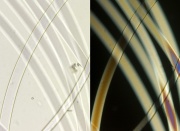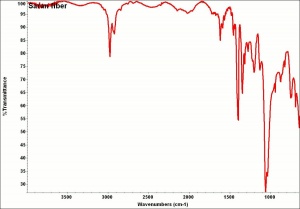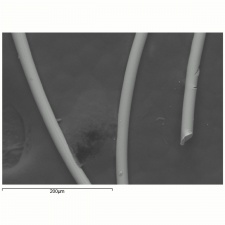Difference between revisions of "Saran fiber"
| Line 30: | Line 30: | ||
Softens at 115 C and lose strength at 99C. | Softens at 115 C and lose strength at 99C. | ||
| − | + | Combustible but self-extinguishing. May release acids when heated. | |
== Sources Checked for Data in Record == | == Sources Checked for Data in Record == | ||
Revision as of 18:27, 20 May 2020
Description
A generic name for manufactured fibers in which the fiber-forming substance is any long chain synthetic polymer composed of at least 80% by weight of vinylidene chloride units (Federal Trade Commission definition). Originally a trademark material first sold by Dow Chemical in 1940, saran is now a commonly used name for films and fibers made from Polyvinylidene chloride. Saran fibers have good chemical resistance to acids and alkalis and do not lose their strength in sunlight. They are resistant to water and insects. In addition, saran fabrics do not tend to retain dirt and are easy to clean. Saran fabrics are heavy. They have been used for home furnishings, automobile upholstery, belts, sports bags and shoes. Saran, however, is expensive and most applications now use olefins or other high-performance fibers.
Synonyms and Related Terms
saran fibre; poly(vinylidene chloride) fiber; polyvinylidene chloride; Saran® [Ametek]; Piviacid; Velon [Firestone Industrial Plastics]; Permalon [Pierce Plastics]; Enjay®
Other Properties
Resistant to acids, alkalis, sunlight, bleaches. May be damaged by ketones, carbon tetrachloride, alcohol, perchloroethylene. Resistant to insects and bacteria. Fibers are transparent and smooth. Cross section = circular. Tenacity = 0.7-2.4 g/denier (dry or wet); Elongation = 15-30% (dry or wet); Moisture regain = 0.1-1.0%
Burns with green flame producing pungent odor and evolving HCl.
| Melting Point | 160-177 |
|---|---|
| Density | 1.1-1.7 |
Hazards and Safety
Softens at 115 C and lose strength at 99C.
Combustible but self-extinguishing. May release acids when heated.
Sources Checked for Data in Record
- G.S.Brady, Materials Handbook, McGraw-Hill Book Co., New York, 1971 Comment: p. 850
- Hoechst Celanese Corporation, Dictionary of Fiber & Textile Technology (older version called Man-made Fiber and Textile Dictionary, 1965), Hoechst Celanese Corporation, Charlotte NC, 1990
- Rosalie Rosso King, Textile Identification, Conservation, and Preservation, Noyes Publications, Park Ridge, NJ, 1985
- Marjory L. Joseph, Introductory Textile Science, Holt, Rinehart and Winston, Fort Worth, TX, 1986
- J.Gordon Cook, Handbook of Textile Fibres:II Man-made Fibres, Merrow Publishing Co. , Durham, England
- Wikipedia, the free encyclopedia, at http://www.wikipedia.com Comment: http://en.wikipedia.org/wiki/Saran_%28plastic%29 (Accessed Nov. 9, 2005)




